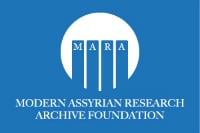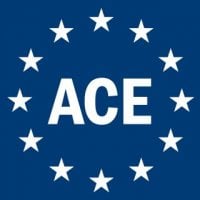This article is going to show you the ongoing crusade for the past 40-50 years against the Assyrian name and identity by the anti-Assyrians so called Arameans.
For more information about the Assyrian identity and about anti-Assyrians so called Arameans see this program which Assyria TV published in 2012
Assyria TV also published this program in 2014 where they revealed anti-Assyrians revisionists.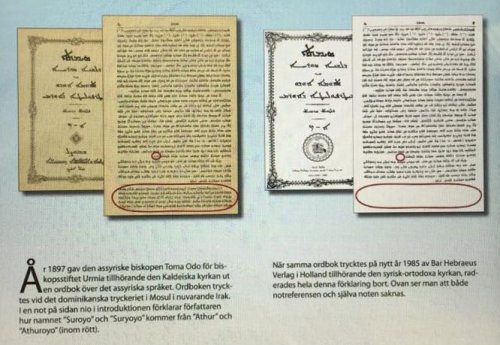
Note: In year 1897 the Chaldean bishop Mor Toma Odo published a dictionary in the Syriac language. In this red marked section at page 9 he described that the term "Suroyo" and "Suryoyo" comes from "Athur" and "Athuroyo". When the same dictionary was published again in 1985 by Bar Hebraeus Verlag which is associated with the Syriac Orthodox Church in the Netherlands this whole section was removed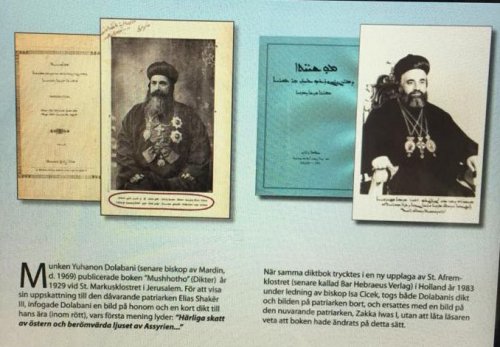
Note: The Syriac Orthodox monk Yuhanon Dolabani (later the bishop of Mardin, 1969) published the book "Mushhotho" (Poems) year 1929 in the St. Mark Monastery in Jerusalem to show his appreciation to the Syriac Orthodox Patriarch Mor Elias Shaker III. Dolabani published a picture of him and a short poem in his honor, which first sentence read: "Glorious treasure of the east and the praiseworthy light of Assyria". When the same poetry book was published by St. Ephrem Monastary (later called Bar Hebraeus Verlag) in the Netherlands year 1983 under the direction of Syriac Orthodox bishop Mor Yulius Isa Cicek, both the poem by Dolabani and the picture of the Patriarch was removed and was replaced with a picture of the current Syriac Orthodox Patriarch Mor Zakka Iwas I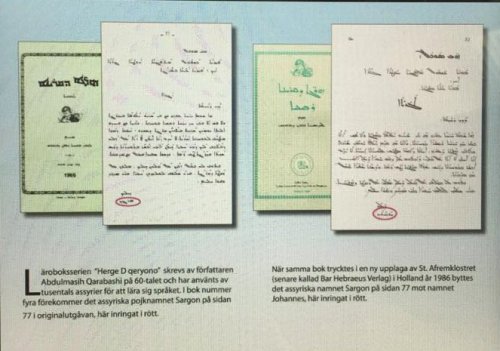
Note: The book serie "Herge D qeryono" was written by the author Abdulmasih Qarabashi in the sixtees and have been used by many Assyrians to learn the Syriac language. In the fourth book the assyrian name Sargon is mentioned at page 77 which is marked with red, however when the same book was published by St. Ephrem Monastary (later called Bar Hebraeus Verlag) in the Netherlands in year 1986, the Assyrian name was replaced with the name John
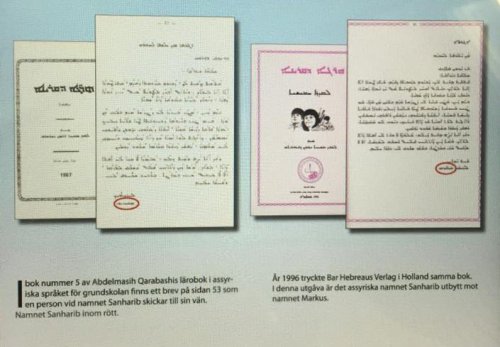
Note: In his fifth book by Abdelmasih Qarabashi, at page 53 their is one letter and the name of the boy in the red marked section who sent this letter is named Sanharib. In year 1996 Bar Hebraeus in the Netherlands published the same book, but in this version the Assyrian name Sanharib was replaced with the name Mark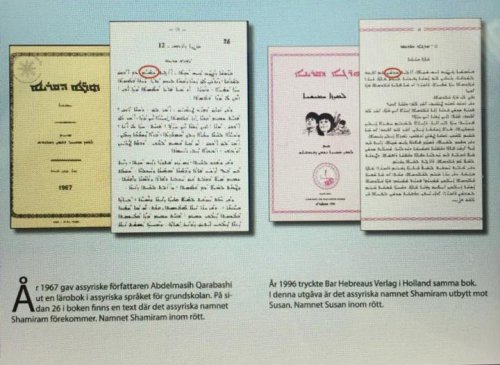
Note: In the year 1967 the Assyrian author Abdelmasih Qarabashi published a book for the Syriac language for the elementary school. The Assyrian name Shamiram is mentioned in the book at page 26 which is marked with red. In year 1996 Bar Hebraeus Verlag in the Netherlands published the same book, but in this version the Assyrian name Shamiram is replaced with Susan

Note: We can see the original poem which was written by Syriac Orthodox bishop Mor Philexenos Yuhanon Dolabani. It says ‘Othur habibtho’, which means ‘beloved Assyria’
Note: We can see the revised version which was changed by Syriac Orthodox bishop Mor Julius Isa Çiçek. It now says ‘Suriya habibtho’, which means ‘beloved Syria’

Note: The following poems/songs have been collected by Syriac Orthodox deacon Nahir Akcay Hahoyo. They have been published by Syriac Orthodox bishop Mor Philoxenus Mattias Nayis who was the former secretary of Syriac Orthodox Patriarch Mor Ignatius Zakka I Iwas from 2008 until 2012, in the monastery of St. Ephrem the Syrian, Saydnaya: Damascus, Syria. This book has been published between those years
Note: The original poems/songs are in this book which Chamiram Khouri collected and afterwards have been published by the Thomas Press in Beirut, Lebanon. The original songs are as old as beginning of the 20th century
Note: The original version is shown here with the unchanged words underlined. The underlined words read ‘Suryoye, Othuroye, Chaldoye Oromoye’, which means ‘Syriacs, Assyrians, Chaldeans Arameans’. This version was originally written by corepiscopos Chamoun Gabriel
Note: The revised version is underlined in red. The underlined words read ‘Suryoye Oromoye malfone yaduthone’, which means ‘Syriacs Arameans teachers…’. We can see that the Assyrian name and also the Chaldean name have been erased in the ‘new’ version of the book
Note: The original version is shown here with the unchanged words underlined. The underlined words read ‘Taw lgun Othuroye’, which means ‘Come all of you Assyrians’. The underlined words in the third paragraph read ‘Ow bnay genseh dOrom of yaldeh dChamiram’, which means ‘The sons of Aram also the offspring of Chamiram’. The original poem/song has been written by Malfono Naum Faiq

Note: The revised version is underlined in red. The underlined words read ‘Taw lgun ow Suryoye’, which means ‘Come all of you Syriacs’. The whole sentence has been altered in the second paragraph. It now read ‘Ow bnay Suryoyutho: of bnay genseh dOrom’, which means ‘The sons of Syriacism: which are the sons of Aram’
Note: The original version is shown here with the unchanged words underlined. The underlined words read ‘Son of Syriacs Arameans Assyrians which you are a son of’. The original version was written by the Assyrian composer and musician, Gabriel Asaad and Yuhanon Qashisho

Note: The revised version is underlined in red. The underlined words read ‘bar Suryoye bar malfone: yaduhtone itay bar’, which means ‘Son of Syriacs son of teacher: scholars which you are a son of’

Note: Were the "Nestorians" named 'Assyrian' by the Anglican Missionaries prior to World War 1? Let us examine John Joseph's statement in which we depict a scanned page from the 1606 memoirs of Richard Field (scholar)- written 300 years before World War 1. It says the Assyrians and the Indians were unjustly named 'Nestorians'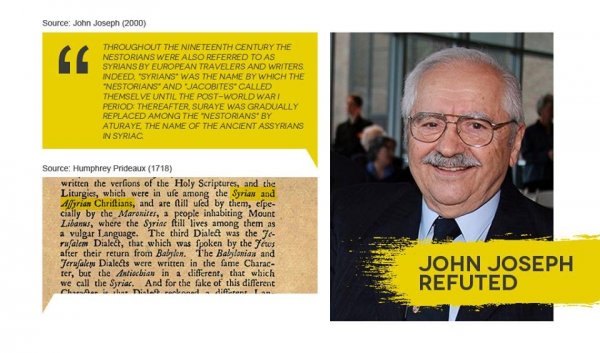
Note: Were the "Nestorians" called Syrians by the European missionaries, linguists, scholars and historians whom infiltrated the Orient since the 16th century? Or were the Nestorians recognised as Assyrian? Let's examine this excerpt from 1718. It says Syrian and Assyrian Christians 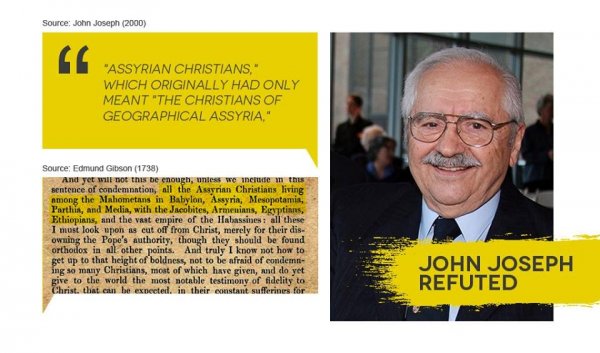
Note: Another conspiracy theory that is propagated by Aramean organisations, especially amongst their "historians" is that the only reason why Assyrians were mentioned throughout the ages was due to the fact they lived in geographical Assyria. Below is a source published in 1738 which clearly attests of Assyrian Christians living in Babylon, Assyria, Mesopotamia, Parthia and Media amongst many other communities. Evidently outside the borders of geographical Assyria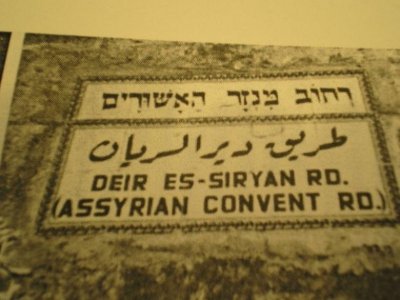
Note: The street sign in Jerusalem says here "Assyrian Convent Road" where the Syriac Orthodox Church is located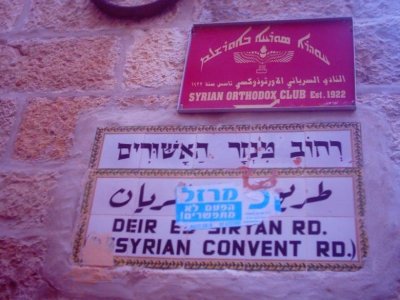
Note: In this photo the first falsification is revealed of the same sign, the first letter in "Assyrian" is covered and now it says "Syrian Convent Road" and they have also add the modern Aramean eagle at the top of the sign 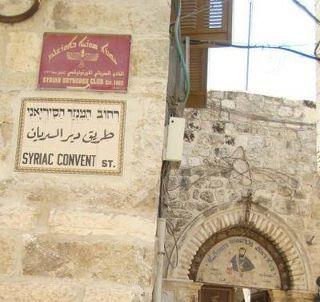
Note: In this photo you can see that they have changed the whole sign and now it says "Syriac Convent Road" and the modern Aramean eagle is at the top of the sign. Their is no trace left of the Assyrian name and identity 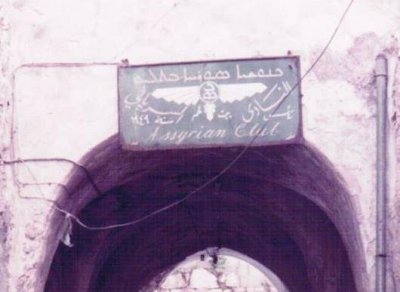
Note: The street sign in Bethlehem says "Assyrian Club" where the Assyrian association is located, they use Ashur as their symbol 
Note: In this photo you can see that the first falsifaction is revealed they have add a new sign and it says now "Syrian Club", however they still use Ashur as their symbol
Note: In this photo you can see that they have changed the whole sign to a new one adding the modern Aramean eagle and it says "Syrian Club". Their is no trace left of the Assyrian name and identity
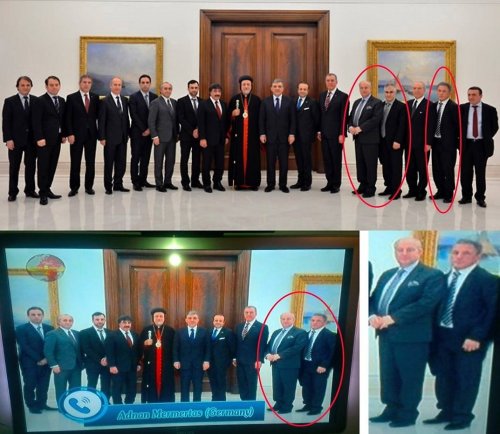
Note: When the Turkish President Abdullah Gül had meeting in Ankara with the Syriac Orthodox Bishop Yusuf Cetin and leaders from both Assyrian & Aramean Associations, Suryoyo Sat manipulated the picture they took where they erased the Assyrian leaders so that only Aramean leaders would be presented at the Aramean propaganda channel Suryoyo Sat read more about this here.



